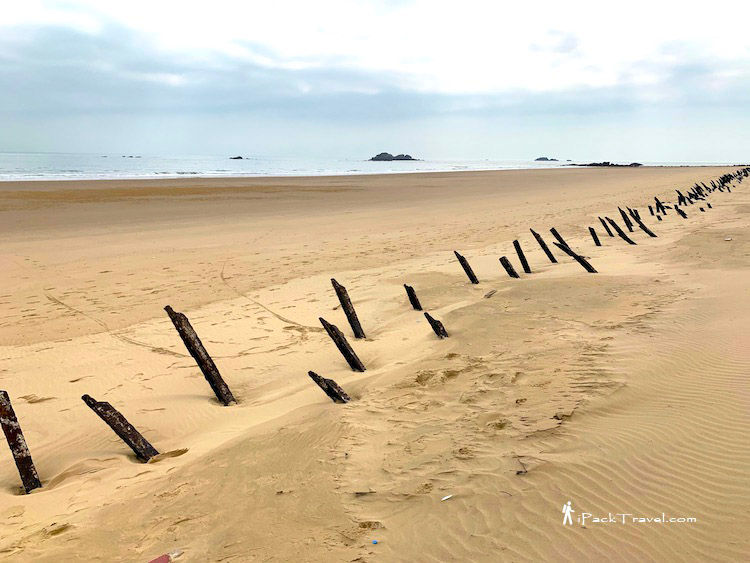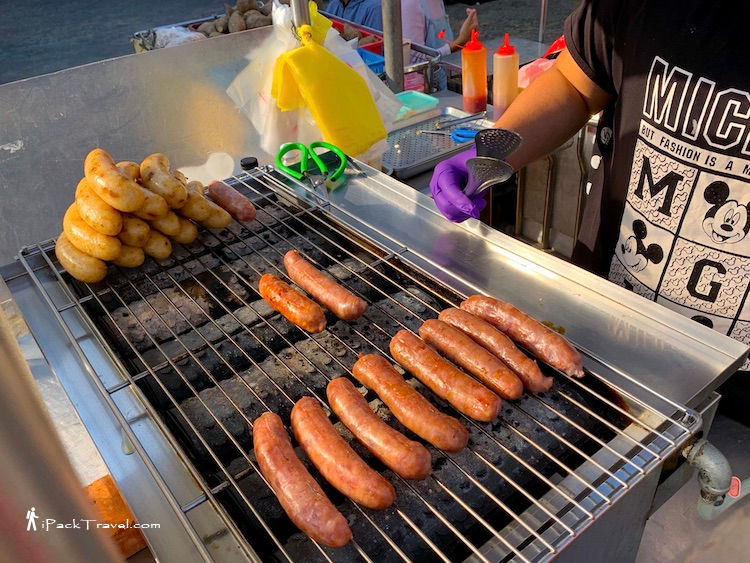2019 Taiwan Day 3: Cycling & Hunting Wind Lion Gods around Jincheng Town
- Rick

- Aug 30, 2020
- 7 min read
Updated: Sep 13, 2020
Previous:

Date: 16th November 2019, Saturday
There was a tour bus service (Line E) by Taiwan Trip (台湾好行) on Kinmen Island to bring visitors to see various Wind Lion Gods (风狮爷) statues around the central and northeastern parts of Kinmen where most of the statues were located. The tour bus would ferry visitors to each Wind Lion God location, allow few minutes for photo-taking, then back to the bus and head for the next one. There were two routes to find a total of 31 statues — the tour bus would use half a day for each route. However, the service operated from Shanwai Station (山外车站) and only on Saturdays.

It was a Saturday this day. Instead of getting up early to take a bus from Jincheng Bus Station to Shanwai Bus Station and change to the Line E tour bus by 8:25am, I opted to do something different. I decided to cycle around Jincheng Township and hunt down each Wind Lion God myself at my own leisure pace. The route would be different from the tour bus service and the set of Wind Lion God statues that I would find would be different too. I preferred the exploration-style adventure instead of a quick-way to photograph 31 statues in a day — that was for tourists.
And my little adventure would be different from others.
To start the day, I went to Hong Ya Burger (弘爷汉堡), which was just a stone throw from Backpack Home 497, for a typical Taiwanese-style breakfast. I ordered a chicken burger and hot corn soup. The latter was a Taiwanese favourite.

Then I went back to the hostel to borrow a bicycle. It was not in tip-top conditions, a little rickety, but was free and usable. Bicycle rental services had literally died out for some reasons on Kinmen, which had encouraged eco-tourism using bicycles for many years. I hardly saw anyone on bicycles for the last two days. Most Taiwanese tourists preferred to use scooters to get around these days but foreigners would require appropriate licenses to ride them.
Anyway, my cycling-cum-hunting-adventure began. First thing was to get out of Jincheng Town. There were many vehicles on the roads and scooter riders were traveling in any directions they like. At some road junctions without traffic lights, I had to circle around them so I could get across. It took a while to exit the town.
Once out of Jincheng town, the journey became easier with much fewer vehicles — it felt as if my grandfather owned the roads. And I did not encounter another cyclist this whole day. I headed for the nearest Wind Lion God to Jincheng town. Noted that it was a cloudy day.
Two kilometres later at Xiashu (夏墅), I found Xiashu Wind Lion God (夏墅风狮爷) in the courtyard of a residence. I took a photo of the statue from outside the compound and continued to the next one.

(I found a total of 10 Wind Lion Gods on this cycling tour around Jincheng and Jinning townships. To avoid an overly long account on each of the statues in this post, I created a separate post solely on the Wind Lion Gods hunting-adventure, along with detailed routes and map on each of their locations. I will focus on other sights along the journey in this post.)
I wanted to focus on finding the statues and skipped a short detour to visit Jiangong Islet (建功屿) near Xiashu village — it was a mistake as I missed the low-tide window to walk across the sea to the islet. I did come back on Day 4 on a last-minute attempt but still missed the opportunity to get on the islet.
On the way to the second Wind Lion God at Guanlubian village (官路边), there are more sorghum paddy fields by the road sides. They were much larger than the sorghum fields I saw on Little Kinmen on Day 2.

After finding Guanlubian Wind Lion God (官路边风狮爷), I came to a small temple where Kinmen City Wind Lion God (金门城风狮爷) was located. Opposite the temple was Ming Yi Old Street (明遗老街) that was seldom mentioned in travel guides. This 400-year-old street from the Ming Dynasty was the oldest street on Kinmen. Three of the units were converted to museums for travellers to know more about the old street's history. A renovated pathway led to the North Gate (北门).

Seeing that the old street was devoid of people during the off-peak season, I decided to continue on my journey to seek out the Wind Lion Gods instead of detouring to the old city gate.
Next was Gugang Wind Lion God (古岗风狮爷) standing at a road junction. Just a short distance after the junction was a small field of rosella plants.

When I was taking photos of the red plants, a local man rode by on a scooter and pointed out several peacocks beyond the rosella field to me. He rode off before I could thank him. What a surprise!

The next stop was at Guanli (官里), where Guanli Wind Lion God (官里风狮爷) was. Most of the houses in the village were well-preserved and still featured the traditional Minnan-style swallow-tail design on the rooftops.

After leaving Guanli Village, I cycled for some distance until I reached Oucuo Village. Following a narrow path besides the village, I found Oucuo Wind Lion Gods (欧厝风狮爷) at a secluded spot nearer to Oucuo Beach (欧厝沙滩). I decided to take a short break from the cycling and stroll on the beach.
A signboard on the beach mentioned a "sleeping" tank along the coast that would surface during low tides. It was low tide at that moment, but I could not find the M18 tank after walking on the beach for a long while. I gave up and continued on my journey. I was told later that it laid at one end of the beach — among that pile of rocks in the photo below. I would have seen it if I had continued walking for another 15 minutes.

The next Wind Lion God was at Houhu (后湖). Although I was geographically to the south of Jincheng Town, I had actually crossed the "boundary" into Jinning Township — well, not that it really matters.
Houhu Wind Lion God (后湖风狮爷) was situated at one end of Kinmen Airport's runway. I thought it might be a good spot to take a photo of an aircraft taking off or landing, but a check on the airport's flight schedules showed that the next flight would be about an hour away. So, I continued to find Xiguoshan Wind Lion God (昔果山风狮爷), which brought me closer to Kinmen Airport. The airport was just 4km from Jincheng Town.
After Xiguoshan, there was no other Wind Lion God statues for some kilometres to the east (as shown on Google map), I decided to U-turn as there were two other statues between Xiguoshan and Jincheng Town that would complete the southern circuit and end at Jincheng Town.
Along the way to Dongzhou (东洲), where the next Wind Lion God stood, I passed by Kinmen Kaoliang Liquor Factory (金门酒厂). I decided to drop in to tour the facility and, hopefully, could buy some sorghum wine flavoured foodstuff since it was already lunch time. But, unlike Puli Brewery in Nantou (南投埔里酒厂), which I visited in 2008, the Kinmen factory mainly had its own range of Kaoliang liquors for sales. It did have a small section that sold drinks, light snacks and ice-creams. I bought a can of chilled coffee to drown a small glass of chilled Kaoliang liquor that I sampled at the factory. Oh, did I just concocted a cup of Kaoliang-coffee in my stomach?

I did not get a bottle of Kaoliang liquor at the factory — even though it was a must-buy on my travel list — as I still had 14 days of island-hopping before flying home. I planned to get a bottle on the Matsu Islands towards the end of the trip.
After locating Dongzhou Wind Lion God (东洲风狮爷) and Banglin Wind Lion God (榜林风狮爷), I was quite near to Jincheng Town. A check on Google map showed that I had covered all 10 Wind Lion Gods to the south and east of Jincheng Town. Another 3 statues were spread out to the north but I was tired and with a butt pain from the hard bicycle seat, Otherwise, I would want to explore as much as I could.
Anyway, it was already 1:20pm, a good time to return to Jincheng Town and have lunch.
I cycled back to the hostel, returned the bicycle to its parking place, and headed out again. It was already 2:30pm when I walked through the town. I had missed the lunch hours. Most food outlets on Kinmen would close after 2pm and resume at around 5pm or 6pm. I decided to go for some of my favourite Taiwanese street food in Jincheng Old Street.

There were not many options at this hour, so I ordered from the two stalls that were opened. I had one sorghum-flavored sausage and smelly tofu. Smelly tofu was my must-have on every trip to Taiwan. And the sausage was really nice with sorghum fragrance — this was not my first time eating this.

Then I went back to the inn to wash down, relax and chat with fellow travellers in the common area of Backpack Home 497 until it was time for dinner.
At 6pm, I went in search for a restaurant that was recommended by a fellow traveller. I came to the famous Niu-er Ye Restaurant (牛二爷). Without hesitation, I ordered their signature dish, which was the "Three Beef Treasures Noodle" (牛三宝). The three treasures were the beef tendon, tripe and brisket.

It did not occur to me when I ordered the noodle that this was the third time I had beef noodle for dinner straight for all three days since I arrived on Kinmen. I knew that I should have tried something different, but I would always go for the signature dish on first visit to a restaurant.
After dinner, I returned to the hostel right away. I was super tired after the cycling. The winds were getting stronger and the air were much cooler. It was early winter but it would not snow on Kinmen.
Next:
Day 4: writing...



Comments